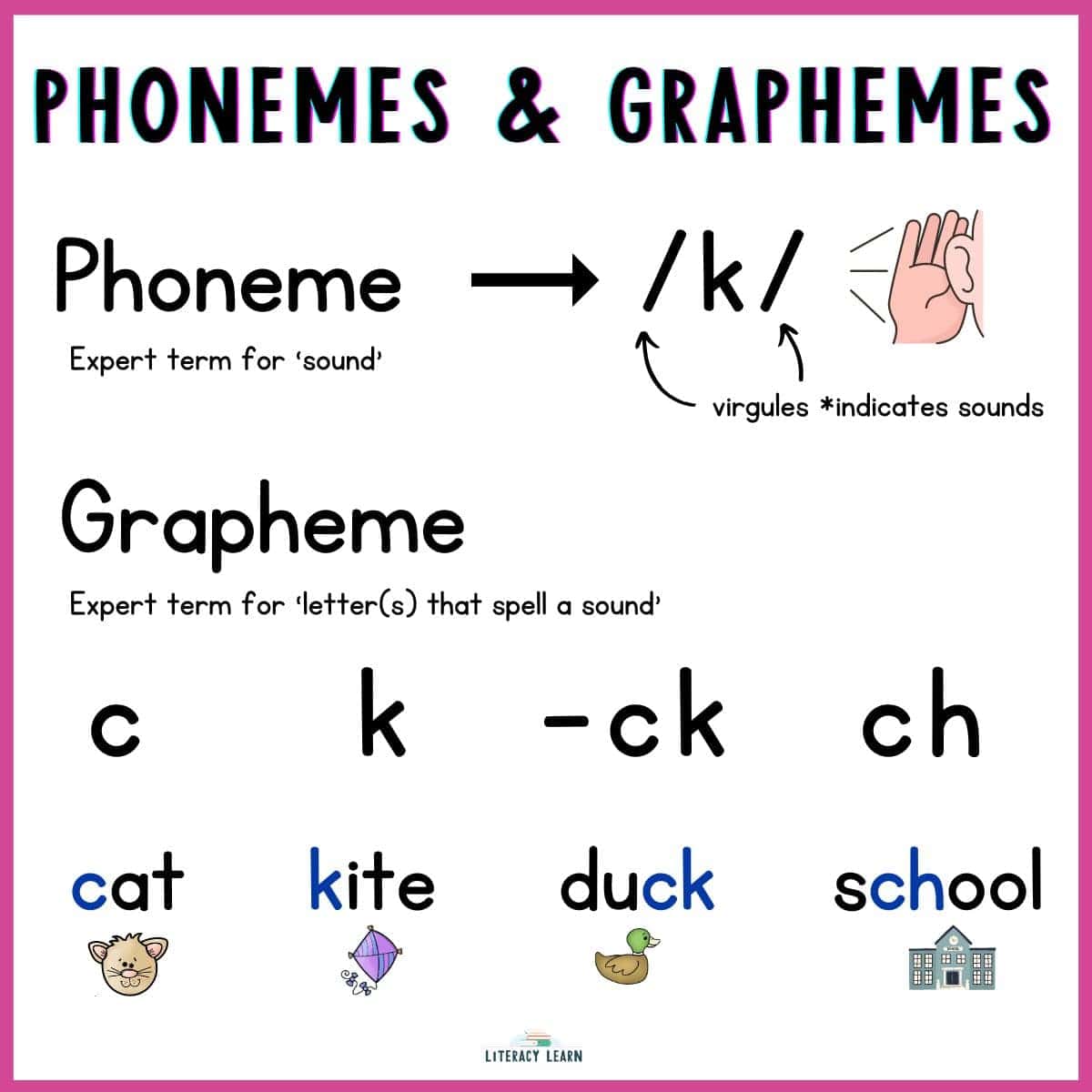44 Phonemes Chart – Free Printable!
This post may contain affiliate links. As an Amazon affiliate, we earn from qualifying purchases.
Learn all about the 44 Phonemes in the English language. You’ll get expert info and a free printable 44 phoneme chart with sounds, letters, and pictures. It’s a valuable resource for anyone wanting to learn more about all the sounds in the English language!

What Are the 44 Phonemes in English?
Phonemes are the individual units of sounds that make up spoken language. In English, most linguists agree that there are 44 unique phonemes, meaning every word we speak is constructed from a combination of these 44 foundational sounds.
These phonemes break down into two main categories: Vowel sounds and Consonant sounds, with 19 vowel phonemes and 25 consonant phonemes in English.
Each phoneme is also classified as either voiced or unvoiced. A voiced sound, like /m/, engages the vocal cords, creating a vibration, whereas an unvoiced sound, like /p/, is produced without this vibration.
To get even more specific, each phoneme can also be categorized by its unique articulatory features, which describe how and where we shape these sounds in the mouth.

Consonant sounds are organized by their place and manner of articulation. The “place” is where the sound is made, and the “manner” is how the sound is made.
- Consonant sounds are categorized as stops, nasals, fricatives, affricates, glides, and liquids.

Vowel sounds are grouped into:
- short (lax) vowels, diphthongs, long (tense) vowels, r-controlled vowels, and schwa.
On a sound wall, vowels are organized by position of articulation which looks like a ‘vowel valley,’ with the schwa, r-controlled vowels, and diphthongs outside of the valley.
🧑🏼🏫Looking for resources to teach vowels and consonants? Grab our free vowel and consonant worksheets.
Using a Phonemes Chart
The 44 Phonemes chart (download free below!) is a comprehensive printable list of all 44 phonemes in English. The sounds are listed in a logical order, grouped by vowel sounds and consonant sounds and broken down by similar features.

We also included other essential information:
- Articulatory Features
For consonants, you’ll see terms like stops, nasals, fricatives, affricates, glides, and liquids. For vowels, you’ll see terms are short (lax), long (tense), diphthongs, r-controlled, and schwa. - Picture Keywords
These common pictures provide support so kids can anchor the sound to something they already know (the picture), and it helps them say the correct sound. (Bonus: We use the same pictures keywords on our sound wall & phonogram cards!) - Graphemes
We included the most common graphemes to spell each sound. This is super helpful for kids as they connect phonemes to graphemes. - Example Words
Real words are listed with the target grapheme underlined, so kids make the connection that all words are made up of individual speech sounds.

Ways to Use the Phoneme Chart
The IDA says that explicit instruction is an essential component of structured literacy.
So we’re outlining a few ways to use this chart to teach the 44 phonemes explicitly, whether you’re introducing speech sounds or using it for reading, spelling, or pronunciation. It’s great for speech therapists, teachers, parents, or students to use!
Reading
Knowing the 44 sounds of English helps kids with reading because it builds their phonemic awareness and phonics knowledge. The National Reading Panel identified these as essential pillars of literacy.
Literacy instruction should follow a Speech to Print approach. Phonemic awareness relates to speech – identifying and working with individual speech sounds in words. So in order to master this component, kids obviously need to learn about speech sounds!
And then there’s phonics. This is where kids begin to link speech sounds to the corresponding letter representations, making those sound-symbol connections through the process of orthographic mapping.
Once children understand the relationship between letters and sounds, they can decode unfamiliar words. They can break the words apart, sound by sound, allowing them to decode more efficiently. This is essential for reading development and ultimately leads to fluency success.
Spelling
For kids to be successful spellers, they need to be able to isolate individual speech sounds within words. And young children often confuse similar sounds in English, like /f/ and /th/. This often translates into a child spelling as errors.
My young students often write the letter f when they hear the digraph /th/ sound. They’ll write fink for think or fen for then.
So using a phoneme chart with the written graphemes can be VERY helpful for correcting these errors. It also helps kids make sound-symbol connections – an essential component of structured literacy.
Pronunciation
You can use this chart chart to help kids discover how speech sounds are made. This can help them with correctly pronouncing a word, both in speech and in reading.
Once kids learn the phonemes, they can begin to accurately produce sounds in words. For instance, knowing the difference between /p/ and /b/ helps kids correctly pronounce words like “bit” and “pit.”
Don’t be afraid to use the terms listed beside each term, called articulatory features (nasals, stops, fricatives, etc). These will help kids think about sounds that share similar features. You can ask students questions like:
- “Think about what you are using to make that sound?”
- “Is anything blocking the sound when you form that sound?”
- “Are you using your vocal cords?”
A Note About Dialects
In the U.S., there are many different dialects, each with its own unique sound patterns (Moats & Tolman, 2019).
It’s important for teachers to respect these dialects and not criticize them. However, teaching the difference between formal and informal language is still necessary.
For example, many of my Spanish-speaking students find the /sh/ sound difficult because it doesn’t exist in Spanish.
I compare this to how I struggle with rolling my R’s in Italian—it’s not wrong, just different. We must ensure we address these differences with respect.
Related Resources
Curious and want to learn more? Check out our other helpful resources!
Reference: Moats, L.C., & Tolman, C.A. (2019). LETRS: Unit 1 (3rd ed.) Dallas, TX: Voyager Sopris Learning.
Download & Print
DOWNLOAD TERMS: All of our resources and printables are designed for personal use only in homes and classrooms. Each teacher must download his or her own copy. You may not: Save our files to a shared drive, reproduce our resources on the web, or make photocopies for anyone besides your own students. To share with others, please use the social share links provided or distribute the link to the blog post so others can download their own copies. Your support in this allows us to keep making free resources for everyone! Please see our Creative Credits page for information about the licensed clipart we use. If you have any questions or concerns regarding our terms, please email us. Thank you!
👂 More Phonological Awareness Freebies: Phoneme Manipulation Worksheets, Blending Sounds Practice.


